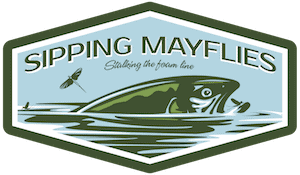THE BEST FLY FISHING BOOKS OF ALL TIME
December 5th, 2024
The best fly fishing books are always authored by obsessed fly fishermen—the ones who can’t think about anything else. They constantly experiment, and they question everything. Generally, they’re rebels.
I read a lot of fly fishing books, all non-fiction, both new and old. If you can name it, there’s a pretty good chance I’ve read it or am reading it.
Some of the books I’ve read were inspiring works of wisdom that helped shape me as an angler, while others were utterly unremarkable or outdated. As a result, I’ve put together this list of must-read fly fishing books—the best of all time.
I’ve read every one of these books cover-to-cover at least once, some twice. They’re listed in no particular order.
This list is for fly anglers who are dedicated to the art. The ones seeking to advance their skills. The ones who trek the extra mile to hit secluded water.
And with that, let’s dive in.
Dynamic Nymphing
The Dry Fly
Lords of the Fly
Fly Fishing Heresies
The Way of a Trout with a Fly
Orvis Fly Fishing Guide
Night Fishing for Trout
Modern Streamers for Trophy Trout
An Entirely Synthetic Fish
Bush Pilot Angler
In The Ring of the Rise
High Sierra Fly Fishing
Trout Tactics
Rivers of Sand
Orvis Guide for Beginners
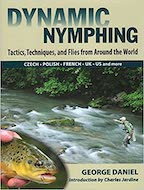
Dynamic Nymphing
George Daniel, the author, is one of those obsessed fly fishermen I mentioned in the introduction. He never stops. He’s part man, part machine. On the inside, he’s a microprocessor-controlled hyperalloy chassis, but on the outside, he’s living human tissue. A cybernetic organism.
When he was a kid growing up in Pennsylvania, George pestered Joe Humphreys about teaching him to fly fish, and Joe eventually relented. You have to appreciate that type of persistence—a persistence he also applies to perfecting his craft, which is nymphing.
His book teaches you the various types of nymphing (Czech, Polish, French, UK, and more), recommended gear, nymph leaders, and on-the-water strategies, with plenty of anecdotes along the way. I took special interest in the long-range nymphing base leader he described—it was brilliant.
His short section on hook sharpening changed the way I fly fish.
There are plenty of great diagrams, drawings, and descriptive photographs throughout the book. He believes that fly fishing is all about adaptation.
Despite being a cybernetic organism, George Daniel is humble. He tells a story about when he was trying to tight-line nymph to some steelhead in a swift riffle. He spent two frustrating hours and finally gave up, catching nothing. An older gentleman, who was an admitted beginner, stepped-in and caught four steelhead in 20 minutes. George swallowed his pride and learned from the man’s uncomplicated technique.
One of my favorite lessons from Dynamic Nymphing is the concept that, if you’re fishing two nymphs with an indicator, the nymph closest to the indicator creates a hinge of sorts, and will mute any takes of the trailing nymph. Great stuff.
If you’re serious about nymphing, this is the only book you’ll ever need. It’s equally valuable for beginners and advanced fly fishermen. In terms of nymphing, this is one of the best fly fishing books ever written.
You can grab a copy here on Amazon.
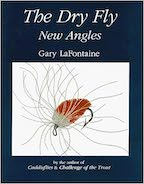
The Dry Fly
Gary LaFontaine’s book will overwhelm you, that’s a promise. By that I mean, there’s so much useful information within its pages that you could spend years parsing-out its genius.
And genius it is.
When I first began reading it, I had my yellow highlighter at the ready. After several pages I realized I’d been highlighting so much that it was almost silly. It’s dense, it’s long, and chances are you won’t finish it. Why? Because it takes effort.
But, those who persist will be greatly rewarded. And the beautiful thing is, very few have ever even heard of this book.
I first heard about this book when I was listening to a podcast featuring Kelly Galloup. He mentioned that this is his favorite book on dry flies, and after having read it, I echo his sentiment.
You can grab your copy here.
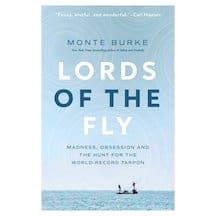
Lords of the Fly
Homosassa, a small gulf coast town in Florida, was the epicenter of fly fishing for tarpon for quite some time. This non-fiction book details the intense stories of the obsessed men who chased tarpon there for decades, including Tom Evans, Stu Apte, Lefty Kreh, and Ted Williams.
The giant egos, the world records, the parties, and the drama—it was an intense place populated by eccentric personalities. The author focuses on the hardcore fly fisherman who would annually dedicate weeks, and even months, all day every day, to chase world record tarpon with a fly.
And this isn’t amateur hour—more than one of the main characters ended up being inducted into the Fly Fishing Hall of Fame.
Lord’s of the Fly isn’t an instructional book, and you won’t learn tactics for catching tarpon. The language is coarse at times, and some of the characters come off as distasteful. But if you’d like to learn more about the history of fly fishing for tarpon, this is the book.
You can pick up your own copy here.
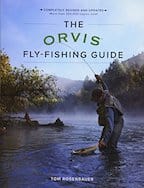
The Orvis Fly Fishing Guide
Despite its generic and uninspiring title, this is the best beginner fly fishing book ever written. More of an instruction manual than a traditional “book,” the knowledge within its 400 pages comes from a lifetime on the water.
Tom Rosenbauer, whose been fly fishing for over 50 years, explains knots, casting techniques, flies, gear, rods, reels, river tactics, stillwater tactics, saltwater vs freshwater, fish species, and everything in between.
He doesn’t assume any level of preexisting knowledge, either, which is why it’s such a great book for beginners. In fact, it’s already sold over 300,000 copies.
Absolutely filled with super high quality pictures and diagrams, this fly fishing guide is top notch with high production values. Even advanced fishers can brush-up on their fundamentals by using this as a reference manual.
If you’re looking for something more catered to experienced fly fishers, Tom Rosenbauer wrote another book called The Orvis Guide to Prospecting for Trout. It’s excellent and will greatly deepen your knowledge of reading the water.
You can grab a copy here.
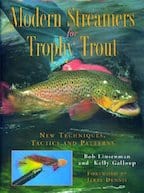
Modern Streamers for Trophy Trout
Kelly Galloup’s name is synonymous with streamers. He authored this book after having spent decades chasing monster trout. His knowledge is so deep that it’s almost information overload.
Kelly tells of the day he began questioning all the conventional wisdom (see a pattern here?) regarding where big trout live. After having spent years hooking into big trout in all the expected spots, he began to believe that the Montana river he knew so well didn’t hold any trout larger than 24-inches.
That is, until he put on a dive mask and regularly saw trout over 30-inches.
Hundreds of hours underwater taught him that the biggest trout in a river system are not holding where you’re taught they’re holding. Where are they? Read the book.
Kelly advanced the concept of articulated streamers, and has tied some of the most famous streamers in the world—with notoriously racy names.
He details what types of retrieves he uses, how the rod is involved (he doesn’t just strip the line in), and what to do when a trout is trailing your streamer.
This book is full of valuable fly fishing knowledge and is definitely one of the best fly fishing books ever written.
If you throw streamers for big trout, or want to learn how, this book is a must-have.
You can grab your own copy here on Amazon.
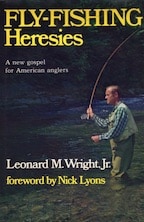
Fly Fishing Heresies
If you’re looking for a non-fiction book written by a man who relishes questioning traditional thought, Fly Fishing Heresies is must-read material. The author, Leonard M. Wright Jr., is an unabashed rebel.
What does he question? Every major tenet of fly fishing.
It may sound like blasphemy, but he even mocks the dead-drift method. [pause for gasps]
Among other things, he calls Izaak Walton a plagiarist and strongly believes you should cast dry flies across stream or downstream—not upstream. This guy has some stones.
He ardently argues that most insects do not lie motionless on the water’s surface as they drift down the river or stream. He postulates that motion is actually what helps trout delineate dead things from living things. He did take some heat for this in his day, with some snarky folks calling his style of fly fishing, “trolling.”
Originally written in 1975, Fly Fishing Heresies is an intelligent, easy to read book that will teach you to think outside the box. It’s certainly earned a spot on my list of the best fly fishing books of all time.
The author wrote another instructional book I really enjoyed, called “Fishing the Dry Fly as a Living Insect.” It dovetails nicely with Fly Fishing Heresies and is definitely worth picking up.
You can grab a copy here.
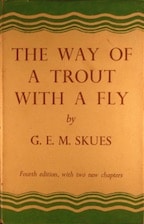
The Way of a Trout with a Fly
The first edition of this book was written in 1921 by British author G.E.M. Skues, a colossal figure in fly fishing. (More on him later.) Throughout the book he intelligently tackles tough questions, such as whether or not trout see color during the daytime, or at night, or both, or neither. No list of the best fly fishing books would be complete without works from GEM Skues–that’s the God’s honest truth.
He explains well thought-out theories on many diverse subjects, often going down very intriguing rabbit holes of thought. He may have been the first angler to conclude that larger trout become primarily piscivorous (fish-eaters).
One of my favorite quotes from the book is, “Never believe a thing you are told about fishing until you have proved it, not only once, but over and over again.” This is a pattern in the book—questioning conventional wisdom. It’s inspiring.
Sometimes you feel like you’re in his head, listening to his internal dialogue as he contemplates various topics related to fly fishing.
He didn’t just target trout, but also grayling, which he called “Brace.” He was a member of a prestigious fly fishing club where it was considered bad form to cast blindly—you could only cast to specific rising fish. They also didn’t allow nymphs, which led to an interesting story that’s difficult to fathom.
The Way of a Trout with a Fly is full of evergreen content, meaning it’s just as relevant today as when it was originally printed in England. And don’t worry, it’s an easy read.
You can grab a copy here.
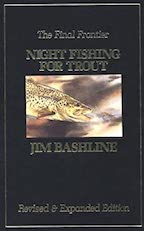
Night Fishing for Trout
As the title suggests, this book is dedicated to the art of fly fishing at night. Admittedly, night fishing isn’t for everyone, but if you’re one of the adventurous souls who daydreams about hooking into a monster brown trout at twilight, this is a must-read book.
The author, Jim Bashline, says that casting flies at night gets into your blood. Big brown trout become more and more nocturnal as they age, so learning the techniques in this book will help you land a “wall hanger,” as he calls them.
I read this book years ago during a long weekend at a seaside lodge, where my eyes were opened to the feasibility of hooking into trout at night—something I hadn’t seriously considered.
His section on how to fish streamers at night was well written and backed-up with extensive trial-and-error experience.
It’s been said that experience is the best teacher, but that she’s also the most expensive. Along those lines, save yourself some time, and learn from Bashline’s deep understanding of nighttime fly fishing.
You can grab a copy here.
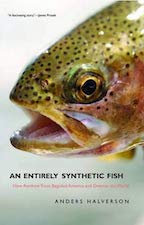
An Entirely Synthetic Fish
The rainbow trout was first discovered in northern California, but now lives on every continent in the world, except Antarctica. The author, Anders Halverson, explains in easy-to-read text the fascinating (and surprising) history of this beloved species.
Rainbow trout were transplanted around the world beginning in the 1800’s, by use of trains and oceanic ships. Decades later, these fish were planted into alpine lakes by dropping them from flying planes! The trips took weeks and it’s a wonder they kept any of the fish alive.
Halverson does a great job of discussing the pros and cons of the rainbow trout proliferation. He’s never biased, and I could never quite tell where he stood on the issues—which is so refreshing.
The most compelling part of the book, for me anyway, was when Halverson explained the effect stocked (farmed) trout have on a fishery. It was eye-opening, in a disturbing sort of way.
It’s always a good idea to educate yourself about the species you’re chasing, and this book covers rainbow trout in the most thorough way possible.
You can grab your copy on Amazon here.
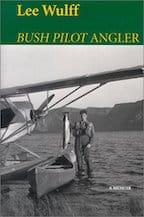
Bush Pilot Angler
This book beautifully details the numerous adventures Lee Wulff experienced while running a salmon fly fishing lodge in New Foundland, and then later in Labrador.
His stories of giant salmon and monster brook trout, stalled plane engines, unreasonable clients, mind-boggling betrayal, and incomprehensible storms will leave you shaking your head.
You’ll learn some tips and tactics about salmon flies and fly fishing techniques, but the real meat is in the risky exploits and big dreams of Lee Wulff. Glorious victories and desperate misfortunes are peppered throughout the memoir.
It’s almost always more fun to live an adventure, rather than experience one vicariously through someone else, but in this case I wouldn’t trade places with him. He’s a guy who repeatedly gets knocked down and keeps coming back for more.
Wulff clearly relishes piloting his Piper Cub float plane—and he never misses an opportunity to push it to its limits, scouring the landscape at low altitude for untouched waters, or cutting through a rainstorm to pick up clients waiting at the town dock.
This is certainly one of the best fly fishing books ever written. If you’ve ever dreamed of running a fly fishing lodge in the remote wilderness, this book will take you there, if just for a few hours.
You can buy a copy here.
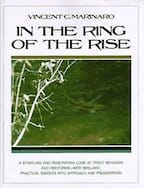
In The Ring of the Rise
This is a masterpiece, a magnum opus if you will, written by Vincent C. Marinaro. In it, he explains, in mind-bending detail, the components of a trout rise. Before I read this book, I had no idea there were so many elements involved.
Marinaro teaches you how to read a rise. In other words, you can pinpoint exactly what type of rise you just saw—sipping at the surface, feeding just below the surface, a refusal, etc. It’s really valuable information, and he uses sharp close-up photographs to help paint the picture.
You’ll learn tactics for each type of rise, and something he calls the “Game of nods.”
In one of the most interesting sections of the book, Marinaro suggests that trout may actually see around corners, so-to-speak. He uses light refraction studies to postulate that trout can literally see what the fly looks above the surface, not just the underside of the fly.
If you’re really serious about becoming the most productive fly fisher you can be, pick up this book and put your thinking cap on.
You can buy a copy here.
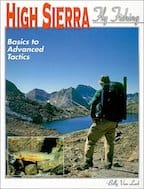
High Sierra Fly Fishing
While the Sierra mountain range lies primarily inside the state of California, I can tell you from personal experience that the principles in this book will apply to all high mountain fly fishing destinations in the United States. It doesn’t matter if you’re in Montana, Idaho, Nevada, Colorado, Oregon, Washington—the tactics still work.
In his book, Van Loek explains high alpine fishing secrets that’ll be well received and easily digestible for both beginner and expert anglers.
How did trout get into all those high altitude lakes in the first place? He’s got your answer.
What’s involved in planning a day trip to an alpine lake? He’s got you covered.
These cold mountain lakes are stillwater fisheries—meaning they can be challenging. Van Loek explains the importance of using shadows to hide yourself while casting, what times of day are most productive, what are expected daily weather patterns at high altitude, and how to use the wind as your greatest ally.
If you’ve thought about how great it would be to fly fish a secluded high alpine lake—and who hasn’t—read this book before you go. There are plenty of safety-related factors that you won’t want to miss.
You can grab a copy here.
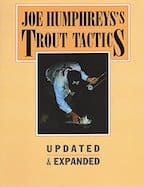
Joe Humphreys’s Trout Tactics
This classic book has been around for almost three decades, and it’s been updated and expanded since then. The author, Joe Humphreys, is perhaps the most recognizable fly fisherman in the world, and he’s earned it.
There’s no fluff in this book—Humphreys educates throughout. The pages are laser-focused on tactics and strategies for dry fly, wet fly, and nymph fishing.
If I were to distill this book down to its core focal point, it teaches you how to catch trout. At the end of the day, isn’t that the whole point?
Its definitely got a “dated” look to it, mainly because the pictures are few and far between, and the sketches and diagrams look like they were done in pencil—they’re just not sharp.
But don’t let that stop you from getting this book. You could read it 10 times and not absorb all the information—it’s that dense, and I’m not even joking. Learn from the master.
You can get your own copy here.
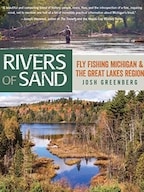
Rivers of Sand
The subtitle of this book is, “Fly Fishing Michigan and the Great Lakes Region,” but don’t make the mistake of thinking it’s only written for folks fly fishing the Manistee river. Authored by Josh Greenberg, owner of the Gates au Sable lodge, I devoured this book during a stay in Jackson Hole, Wyoming.
Greenberg’s prose is very conversational—like you’re on a boat with him floating down the river. He touches on a multitude of subjects, and injects sage fly fishing advice into nearly every anecdote.
This book will make you a better fisherman, but the stories are what kept me riveted. His explanation of what it’s like to be in the middle of a hex hatch, or mousing at night for huge brown trout, glued my eyes to the pages.
One piece of advice he offered—and this is one of many—is to pay attention to the background in your fishing pictures. Choose a spot that’s nondescript, so if people see the picture online, they can’t figure out where the picture was taken. This prevents fishing spots from being overrun (and potentially fished-out) by anglers.
Too many fly fishing authors think they’re poets; or at least they try to be. There’s no snobbishness in Greenberg’s writing—he keeps it real. In one section, he wrote about a well-known fly fisherman who took two years off from fishing so he could study insect hatches. Greenberg said, “That’s like taking two years off from dating so you can practice kissing.” Well said.
This is one of the books I’ve read twice—it’s that good. Every fly angler should grab a copy.
You can get a copy here.
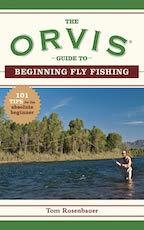
The Orvis Guide to Beginning Fly Fishing
The apt subtitle of this book is, “101 Tips for the Absolute Beginner.” And while this book doesn’t offer anything for intermediate and advanced fly anglers, it’s a must-have for beginners.
Tom Rosenbauer, of Orvis notoriety, teaches you the fly fishing fundamentals—laying the bedrock for future advancement and learning. Casting, flies, knots, gear, water types, terminology, fly lines—it’s all covered in this book’s 208 pages.
It’s a well-written instruction manual for novice fly fishers who want a primer before pursuing the next level. Rosenbauer gets back to the basics and has an easy-to-read style of writing. The book is broken up into short “tips” sections so it’s convenient to read even if you only have ten minutes to spare.
With a price tag hovering right around $12, this should be a no-brainer purchase for entry-level fly anglers.
You can order a copy here.
Summary
Hopefully you’ve gleaned some helpful reading suggestions from my list of the best fly fishing books ever written. This list is clearly comprised of non-fiction books, which is always my preference over fiction. No novels to be found here. Gierach isn’t my cup of tea.
Don’t forget to check out my article on the best fly fishing authors of all time, as well as my list of the best fly fishing podcasts.
This list is fluid. I’ll keep it updated as time progresses, since some titles and authors may get added or removed.
If you think there’s a glaring omission from this list, send me an e-mail and let me know your book suggestion. If I haven’t read it already, I’ll probably pick it up!
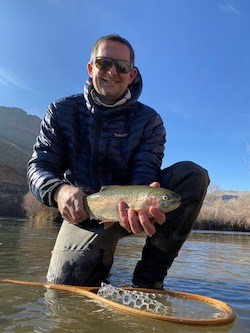
About the Author
My name's Sam and I'm a fly fishing enthusiast just like you. I get out onto the water 80+ times each year, whether it's blazing hot or snow is falling. I enjoy chasing everything from brown trout to snook, and exploring new waters is something I savor. My goal is to discover something new each time I hit the water. Along those lines, I record everything I learn in my fly fishing journal so I can share it with you.
Follow me on Instagram , YouTube, and Facebook to see pictures and videos of my catches and other fishing adventures!
